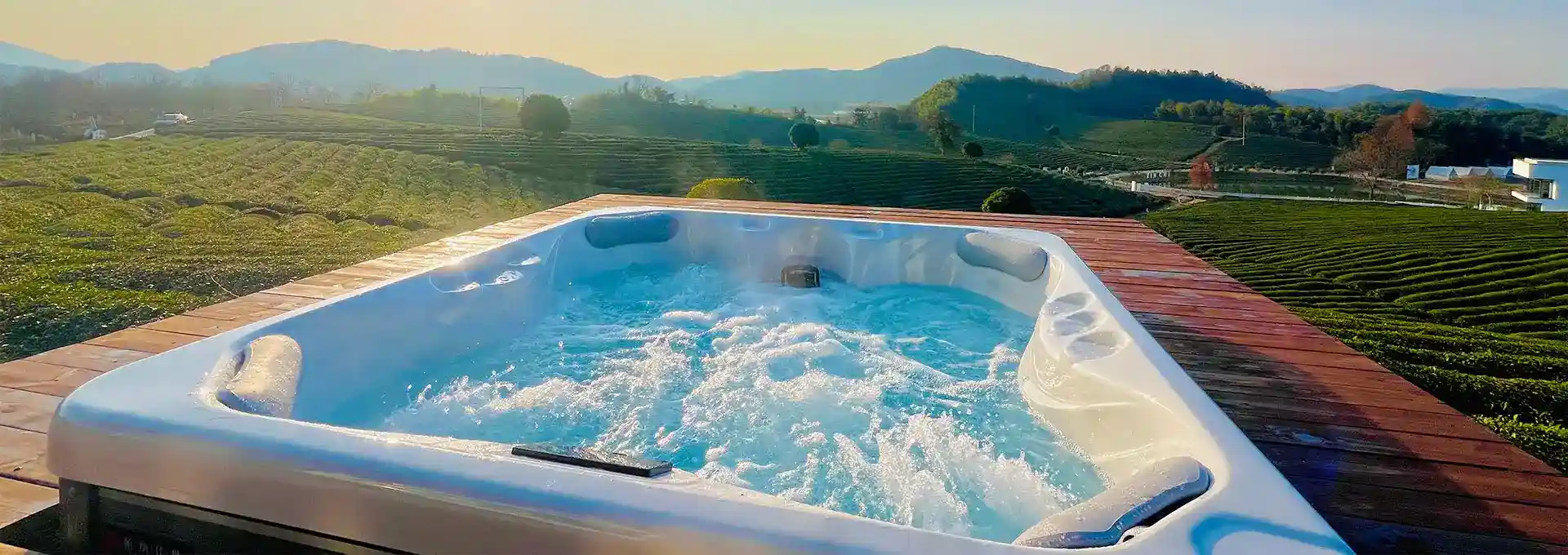What Are the Dimensions of a Swim Spa?
2024-08-29 17:47:48
Swim spas have become increasingly popular for those seeking a compact yet versatile aquatic exercise and relaxation solution. One of the most common questions potential buyers ask is about the dimensions of these innovative water features. Swim spa dimensions can vary significantly depending on the model and manufacturer, but they typically range from 12 to 21 feet in length, 7 to 8 feet in width, and 4 to 5 feet in depth. These dimensions allow for a comfortable swimming experience while maintaining a relatively small footprint compared to traditional pools. Understanding the size options available is crucial for homeowners considering adding a swim spa to their outdoor space.
How much does an outdoor swim spa cost?
The cost of an outdoor swim spa is a significant consideration for many potential buyers. Prices can vary widely based on several factors, including size, features, brand, and quality. On average, you can expect to pay anywhere from $15,000 to $50,000 for a swim spa, with high-end models potentially exceeding $100,000.
Entry-level swim spas, typically ranging from 12 to 14 feet in length, are generally the most affordable options. These models usually cost between $15,000 and $25,000. They offer basic features such as swim jets and seating areas but may have fewer customization options or lower-quality materials.
Mid-range swim spas, often 15 to 17 feet long, tend to fall in the $25,000 to $40,000 price range. These models usually come with improved features such as more powerful swim jets, better filtration systems, and enhanced energy efficiency. They may also offer more seating options and additional hydrotherapy jets for a more luxurious experience.
High-end swim spas, which can be 18 feet or longer, typically cost $40,000 to $50,000 or more. These premium models often boast top-of-the-line features like advanced water purification systems, customizable swim currents, integrated fitness equipment, and smart home compatibility. Some luxury swim spas can even exceed $100,000, offering the ultimate in performance, durability, and customization.
It's important to note that the initial purchase price is not the only cost to consider. Installation expenses can add significantly to the overall investment. Factors such as site preparation, electrical work, and delivery can increase the total cost by $3,000 to $10,000 or more, depending on your specific circumstances.
Ongoing maintenance costs should also be factored into your budget. These include electricity to run the pump and heater, chemicals for water treatment, and regular servicing. On average, you might spend $50 to $100 per month on electricity and chemicals, with annual maintenance costs ranging from $500 to $1,500.
While the cost of an outdoor swim spa may seem substantial, many owners find the investment worthwhile when considering the long-term benefits. Compared to traditional in-ground pools, swim spas often have lower installation and maintenance costs while providing year-round usability in many climates. Additionally, the potential for increased property value and the convenience of having a personal aquatic fitness center at home can offset the initial expense for many homeowners.
What is the difference between a swim spa and a pool?
While both swim spas and traditional pools offer aquatic enjoyment, they have several key differences that set them apart. Understanding these distinctions can help you decide which option best suits your needs, space, and lifestyle.
Size and Space Requirements:
The most obvious difference between swim spas and pools is their size. Swim spas are significantly smaller, typically ranging from 12 to 21 feet in length and 7 to 8 feet in width. This compact size makes them ideal for smaller yards or areas where a full-sized pool wouldn't fit. Traditional pools, on the other hand, can vary greatly in size but are generally much larger, often 20 to 40 feet in length or more. This size difference means that swim spas require less space and are often easier to integrate into existing landscapes.
Functionality and Use:
Swim spas are designed to serve multiple purposes in a compact space. They combine the exercise capabilities of a lap pool with the relaxation features of a hot tub. The key feature of a swim spa is its powerful jets that create a current to swim against, allowing users to swim in place for extended periods. Many models also include hydrotherapy jets and seating areas for relaxation. Traditional pools, while excellent for swimming and general water activities, don't offer the same level of versatility in a compact package. They're great for leisure swimming, playing water games, and accommodating multiple people, but they lack the focused exercise capabilities of a swim spa.
Installation and Maintenance:
Swim spas are generally easier and quicker to install than traditional pools. Many models are self-contained units that can be placed on a properly prepared surface, such as a concrete pad. This means they can often be installed in a matter of days, compared to the weeks or months required for in-ground pool construction. Maintenance for outdoor swim spas is typically less intensive and costly than for traditional pools due to their smaller water volume and advanced filtration systems. However, they still require regular care, including water testing, chemical balancing, and cleaning.
Year-Round Use:
One significant advantage of swim spas is their potential for year-round use. Many models are well-insulated and can be heated efficiently, making them usable even in colder climates. Some swim spas can function as hot tubs, providing a warm, relaxing environment in winter. Traditional pools, especially in colder regions, are often limited to seasonal use unless they are indoor pools or have expensive heating systems.
Cost Considerations:
While the initial cost of a high-end swim spa can be comparable to that of a small in-ground pool, swim spas generally have lower overall costs when factoring in installation, maintenance, and energy use. The smaller water volume means less chemical use and lower heating costs. However, it's worth noting that on a per-square-foot basis, swim spas can be more expensive than traditional pools.
Customization and Features:
Both swim spas and pools offer various customization options, but they differ in their approach. Swim spas often come with built-in features like adjustable current systems, hydrotherapy jets, and sometimes even built-in exercise equipment. Customization in outdoor swim spas usually involves choosing between different models with varying features. Traditional pools, especially custom-built ones, offer more flexibility in terms of shape, size, and added features like slides, diving boards, or integrated spas.
Are swim spas worth the money?
Determining whether a swim spa is worth the investment depends on various factors, including your lifestyle, fitness goals, available space, and budget. To help you make an informed decision, let's explore the potential benefits and considerations of owning a swim spa.
Health and Fitness Benefits:
One of the primary advantages of a swim spa is its ability to provide a comprehensive aquatic workout in a compact space. The adjustable current allows users to swim continuously without the need for turns, making it an excellent option for endurance training. The resistance provided by the water offers a low-impact, full-body workout that can benefit people of all ages and fitness levels. For those with joint issues or recovering from injuries, the buoyancy of water reduces stress on the body while still allowing for effective exercise.
Beyond swimming, many swim spas come equipped with features that support a variety of aquatic exercises. These may include resistance bands, rowing bars, and even underwater treadmills in some high-end models. This versatility allows users to engage in strength training, cardiovascular workouts, and rehabilitation exercises all in one compact unit.
Relaxation and Stress Relief:
Swim spas aren't just for exercise; they also offer significant relaxation benefits. Many models feature hydrotherapy jets similar to those found in hot tubs, providing soothing massage to tired muscles. The warm water can help relieve stress, improve sleep quality, and promote overall well-being. For those with chronic pain conditions like arthritis, regular use of a outdoor swim spa can offer relief and improved mobility.
Space Efficiency:
For homeowners with limited outdoor space, a swim spa can be an excellent alternative to a full-sized pool. It provides many of the benefits of both a pool and a hot tub in a fraction of the space. This space efficiency can be particularly valuable in urban areas or for those looking to maintain a larger portion of their yard for other activities.
Year-Round Usage:
Unlike traditional pools, which may sit unused for a significant portion of the year in colder climates, swim spas can be used year-round. Their efficient heating systems and insulation make them comfortable even in cooler weather, potentially offering a better return on investment through increased usage.
Energy Efficiency:
Modern swim spas are designed with energy efficiency in mind. Their smaller water volume requires less energy to heat and maintain compared to traditional pools. Many models come with features like high-efficiency pumps and LED lighting to further reduce energy consumption. While the initial cost may be high, the long-term energy savings can make swim spas a more economical choice over time.
Property Value:
Adding a swim spa to your property can potentially increase its value, especially in areas where in-ground pools are less common or practical. It can be an attractive feature for potential buyers who are looking for the benefits of aquatic recreation without the maintenance demands of a full-sized pool.
Considerations:
While swim spas offer numerous benefits, there are also some considerations to keep in mind. The initial cost can be substantial, and while maintenance is generally less intensive than for a traditional pool, it still requires regular attention. Some users may find the swimming experience less satisfying than in a full-length pool, particularly if they're used to swimming laps. Additionally, the capacity for multiple users or large gatherings is limited compared to a traditional pool.
Ultimately, whether a outdoor swim spa is worth the money depends on how well it aligns with your personal goals and lifestyle. For those seeking a versatile, space-efficient solution for fitness and relaxation, a swim spa can be an excellent investment. However, it's important to carefully consider your budget, space constraints, and intended use before making a decision. Many potential buyers find it helpful to test out a swim spa before purchasing to ensure it meets their expectations and needs.
In conclusion, swim spas offer a unique combination of exercise, relaxation, and space efficiency that can make them a worthwhile investment for many homeowners. By carefully considering your needs and researching various models, you can determine if an outdoor swim spa is the right choice for enhancing your health, wellness, and outdoor living space.
If you want to get more information about this product, you can contact us at info@iparnassus.com!
References:
1. Swim University. (2023). Swim Spa Costs: A Complete Buyer's Guide.
2. Aqua Magazine. (2022). The Growing Popularity of Swim Spas.
3. Pool Research. (2024). Swim Spa vs Pool: Which is Right for You?
4. Hydropool. (2023). Swim Spa Dimensions and Sizes Guide.
5. SwimEx. (2024). The Benefits of Hydrotherapy in Swim Spas.
6. Endless Pools. (2023). Energy Efficiency in Modern Swim Spas.
7. Home Advisor. (2024). Swim Spa Installation Costs and Considerations.
8. Aqua Tech. (2023). Year-Round Swimming: The Advantages of Heated Swim Spas.
9. Fitness Magazine. (2024). Aquatic Workouts: Maximizing Your Swim Spa for Fitness.
10. Real Estate Today. (2023). How Swim Spas Can Affect Property Values.



